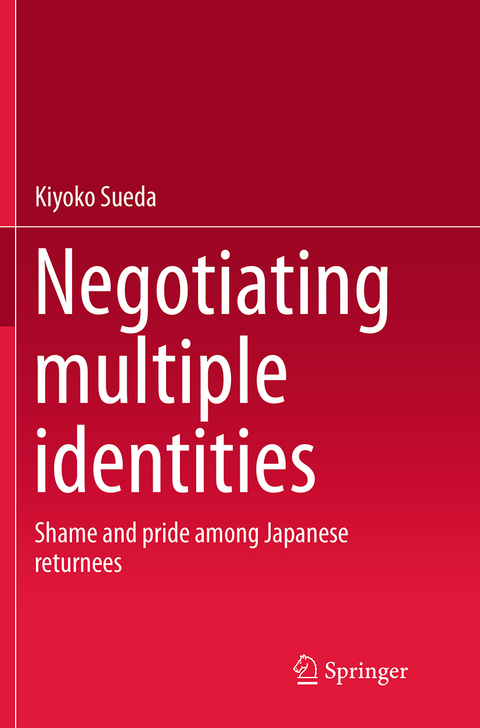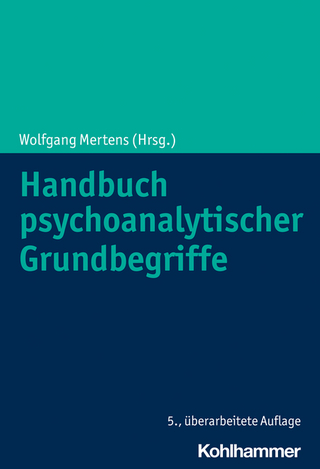
Negotiating multiple identities
Springer Verlag, Singapore
978-981-10-1227-3 (ISBN)
Readers will discover how Japanese returnees deal with shame and pride in face-threatening or face-promoting situations that affect their identity negotiation. Many such returnees stayed abroad because of their parents’ jobs and the author explores variations among them, in terms of how they identify with their identity as a returnee. We discover how there are multiple levels of identities instead of ‘identity’ as a singular.
Two phases of research, carried out across ten years and involving some participants in both phases, are explored in this work. Although the participants in the research are Japanese returnees, the findings drawn from the study have implications for others who spend an extensive period of time overseas, who migrate from one place to another or who have multiple cultural backgrounds.
The book incorporates ideas from Western and Eastern literature on intercultural communication, sociology and social psychology and it blends both micro and macro analysis.
This book is recommended for scholars, educators, students and practitioners who seek to understand better how people negotiate their multiple identities in this globalising world.
Kiyoko Sueda (Ph.D., Lancaster University, 2002) is professor of communication studies and is currently Chair of the Department of International Communication, School of International Politics, Economics and Communication, Aoyama Gakuin University in Tokyo, Japan. She teaches communication theories, interpersonal communication, intercultural communication, and intercultural training. Her research interests include face (social), identities, shame and pride in interpersonal and intercultural communication. She has written on face, identities, reintegration of shame, communication theories, intercultural communication, and methodologies and methods in communication studies. Her co-authored book, ‘Komyunikeishon gaku: Sono tenboh to shiten (Communication studies: Perspectives and prospects)’ is one of the best sellers among textbooks on communication studies in Japan. Her co-edited book, ‘Komyunikeishon kenkyu hoh (Research methods in communication studies)’ was nominated by the Communication Association of Japan as the most outstanding book published in 2011. She has served SIETAR Japan as Vice President from 1998-2001 and 2002-2004, and has served SIETAR Japan and Intercultural Education Society, Japan, as a member of editorial board. She is also engaged in the activities of the Human Dignity and Humiliation Studies organisation and has served as a Global Advisory Board member since 2005.
Forward.- Preface.- Table of Contents.- List of tables.- List of figures.- List of abbreviations.- Chapter 1: Multiple Identities.- 1.1: Purpose of Chapter 1.- 1.2: Identity as singular.- 1.3: Identities as plural, viewed from Symbolic Interactionism.- 1.4: Identities viewed from Social Identity Theory and Self-Categorization theory.- 1.4.1: Background of the theories.- 1.4.2: An overview of the theories.- 1.4.3: Levels of identities.- 1.4.4: The relationship between social identity and personal identity.- 1.4.5: Categories and intergroup behaviours.- 1.5: Negotiation of multiple identities.- 1.6: Summary.-References.- Chapter 2: Research on face in communication studies.- 2.1: Purpose of Chapter 2.- 2.2: The perception of face.- 2.3: Research on face in communication studies.- 2.4: The origin of face.- 2.4.1: Chinese face.- 2.4.2: Japanese face.- 2.5: Summary and implications.- References.- Chapter 3: Shame and pride behind face.- 3.1: Purpose of Chapter 3.- 3.2: Emotions in this study.- 3.2.1: Emotions and sociological theory.- 3.2.2: Emotion as a symbolic interaction.- 3.3: Face and emotions.- 3.3.1: Shame and pride.- 3.3.2: Reintegration of shame.- 3.3.3: Shame and pride illustrated in case studies.- 3.4: Research questions.- 3.4.1: Relationship between face and identities.- 3.4.2: Function of shame and pride in identity negotiation.- 3.5: Summary.- References.- Chapter 4: Japanese returnees (Kikokushijo) as a social category.- 4.1: Purpose of Chapter 4.- 4.2: Japanese returnees as a social category.- 4.2.1: ‘Uniqueness’ of Japanese returnees.- 4.2.2: Factors contributing to make Japanese returnees a social category.- 4.3: Overview of research on Japanese returnees.- 4.3.1: The background of kikokushijo.- 4.3.2: A historical review of research trends.- 4.4: Japanese returnees’ readjustment to Japanese society.- 4.4.1: Returnees’ identity and symbolic interactionism.- 4.4.2: Psychological process of readjustment.- 4.5: The public image ofJapanese returnees.- 4.5.1: How returnees are viewed by their peers and teachers.- 4.5.2: How returnees are portrayed by mass media.- 4.6: Conclusion.- References.- Chapter 5: Research methodology and methods.- 5.1 Purpose of Chapter 5.- 5.2: Epistemological and methodological standing.- 5.2.1: Epistemological approach.- 5.2.2: Methodological approach.- 5.3: Methods.- 5.3.1: The methods used in the present research.- 5.3.2: The ‘Who am I?’ test.- 5.3.3: The PAC (Personal Attitude Construct) method.- 5.3.4: Participant observation.- 5.4: The research participants and procedures.- 5.4.1: The participants in the research.- 5.4.2: The research procedures.- 5.5: The ethical issues concerned.- References.- Chapter 6: Results (The 1st phase of research): Japanese returnees at university.- 6.1: Purpose of Chapter 6.- 6.2: The first phase of research.- 6.2.1: The participants.- 6.2.2: The format of the report.- 6.3: Participant A.- 6.3.1: The WAI and the PAC: A as a Japanese.- 6.3.2: Analysis from the interview with #A.- 6.3.3: Participant observation.- 6.3.4: Conclusion.- 6.4: Participant B.- 6.4.1: The WAI and the PAC: #B as kuroko.- 6.4.2: Analysis from the interview with #B.- 6.4.3: Participant observation.- 6.4.4: Conclusion.- 6.5: Participant C.- 6.5.1: The WAI and the PAC: #C as #C.- 6.5.2: Analysis from the interview with #C.- 6.5.3: Participant observation.- 6.5.4: Conclusion.- 6.6: Conclusion.- References.- Chapter 7: Results (The 2nd phase of research): Japanese former returnees in industry.- 7.1: Purpose of Chapter 7.- 7.2: Research Process.- 7.2.1: Research period and the participants of the second phase of research.- 7.2.2: Research methods and the format of the report.- 7.3: Participant #C.- 7.3.1: Profile of participant #C.- 7.3.2: Semi-structured interview.- 7.4: Participant #D.- 7.4.1: The WAI and the PAC: A as Japanese.- 7.4.2: Analysis from the interview with #D.- 7.4.3: Participant observation.- 7.4.4: Conclusion.- 7.5: Participant #E.- 7.5.1: TheWAI and the PAC: A as a new student.- 7.5.2: Analysis from the interview with #E.- 7.5.3: Participant observation.- 7.5.4: Conclusion.- 7.5.5: The follow-up interview.- 7.6: Participant #F.- 7.6.1: The WAI and the PAC: A as a woman.- 7.6.2: Analysis from the interview with #F.- 7.6.3: Participant observation.- 7.6.4: Conclusion.- 7.7: Conclusion.- References.- Chapter 8: Face (mentsu), shame and pride in identity negotiation.- 8.1: Purpose of Chapter 8.- 8.2: Analysis of the results of the research.- 8.2.1: Threatened face (mentsu) and reinforcement of identities.- 8.2.2: Threatened face and bypassed shame.- 8.2.3: Absence of shame and identity.- 8.2.4: English as a symbol and identity.- 8.2.5: Concern for the other’s shame.- 8.2.6: Wiping off shame and restoring pride.- 8.2.7: Co-existing face needs and their interactions.- 8.3 Conclusion.- 8.3.1: The role of shame and pride in negotiating multiple identities.- 8.3.2: The relationship between face and identities.- 8.3.3: Co-existence of multiple face needs and the interactions among them.- 8.3.4: English as a symbol of returnees and former returnees.- 8.3.5: Methodological contribution.- 8.4: Further work.- 8.5: Summary.- References.- Subject index.
| Erscheinungsdatum | 18.09.2016 |
|---|---|
| Zusatzinfo | 4 Illustrations, color; 20 Illustrations, black and white; XXIV, 180 p. 24 illus., 4 illus. in color. |
| Verlagsort | Singapore |
| Sprache | englisch |
| Maße | 155 x 235 mm |
| Themenwelt | Geisteswissenschaften ► Psychologie ► Psychoanalyse / Tiefenpsychologie |
| Naturwissenschaften ► Geowissenschaften ► Geografie / Kartografie | |
| Sozialwissenschaften ► Soziologie ► Spezielle Soziologien | |
| Schlagworte | Dissoziative Identitätsstörung • Face and emotions of Japanese people • Face and identities of Japanese people • Face and negotiation of multiple identities in Japan • Identities viewed from Symbolic Interactionism in Japan • Identity as singular in Japan • Identity negotiation in Japan • Japan • Japanese returnees and former returnees • Japanese returnees as a social category • Japanese returnees’ readjustment to Japanese society • Japanese Studies • Kikokushijo • Mentsu • Multiple Identities in Japan • Reintegration of shame in Japan • Research on face in communication studies in Japan • Return migration in Japan • Shame and pride of Japanese people • Social Identity Theory and Self Categorization Theory in Japan • The identity negotiation of Japanese returnees • The origin of face in Japan • The perception of face in Japan • The public image of Japanese returnees |
| ISBN-10 | 981-10-1227-X / 981101227X |
| ISBN-13 | 978-981-10-1227-3 / 9789811012273 |
| Zustand | Neuware |
| Haben Sie eine Frage zum Produkt? |
aus dem Bereich


